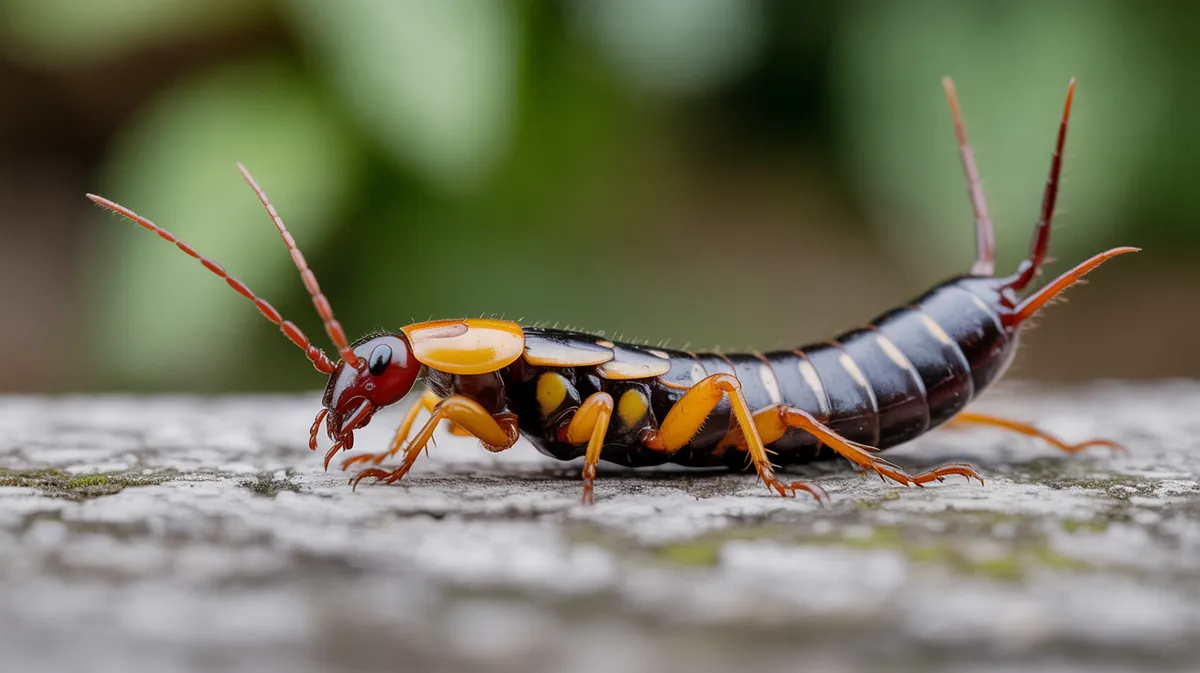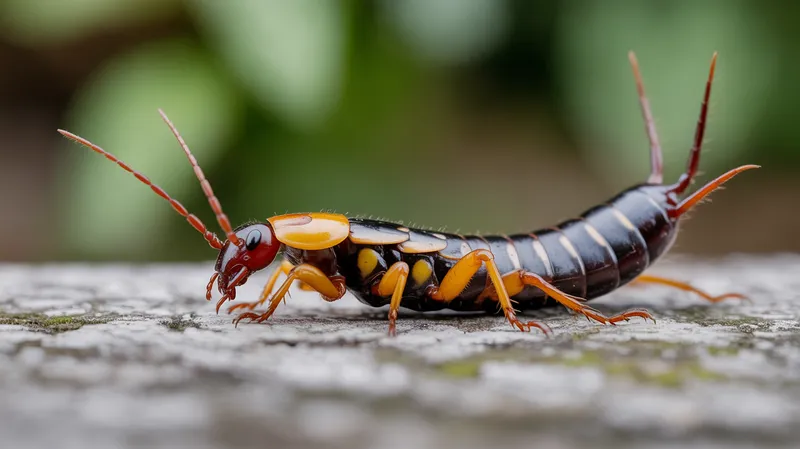
European Earwig
Forficula auricularia

Meet the European Earwig
The European earwig is a small, elongated insect known for its distinctive forceps-like pincers at the end of its abdomen. It is typically brown with lighter legs and measures about 12–15 mm in length. This species is nocturnal and spends the day hiding in moist, dark crevices, emerging at night to feed on a variety of organic material. European earwigs are highly adaptable and can be found in gardens, forests, and urban areas across Europe and in many introduced regions worldwide.
Classification
Invertebrate
Habitat
Gardens, forests, and urban environments
Diet
Omnivore
Lifespan
1-2 years
Conservation
Least Concern
Weight
0.05–0.1 grams
📖Fascinating Facts
Maternal Care
Female European earwigs guard their eggs and tend to their nymphs, cleaning them to prevent fungal infections.
Omnivorous Diet
Their diet includes decaying plant matter, aphids, insect larvae, and even small fruits and flowers.
Curved Pincers
Males have more strongly curved pincers than females, which they use in mating displays and to compete with rivals.
📋Detailed Description
The European earwig (Forficula auricularia) is a slender, elongated insect measuring 12–15 mm in length, with a flattened, reddish-brown to dark brown body and pale yellowish-brown legs. Its most distinctive anatomical feature is the pair of curved, forceps-like cerci at the tip of the abdomen, which are more robust and strongly curved in males and straighter in females. The head is equipped with long, thread-like antennae composed of 12–15 segments, and the mouthparts are adapted for chewing. The forewings (elytra) are short, leathery, and cover only part of the abdomen, while the hindwings are membranous and intricately folded, rarely used for flight. The European earwig is primarily nocturnal, seeking shelter during the day in moist, dark crevices. It is an opportunistic omnivore, feeding on a wide range of plant material, decaying organic matter, small insects, and aphids. Socially, earwigs exhibit subsocial behavior, particularly females, which display notable maternal care by guarding and grooming their eggs and young nymphs. The species is highly adaptable, thriving in diverse habitats including gardens, agricultural fields, forests, and urban environments. Its ability to exploit both natural and human-modified habitats has contributed to its widespread distribution across Europe, North America, and other temperate regions. The European earwig is a species complex, with genetic studies revealing the existence of at least two cryptic lineages. This insect plays a dual ecological role, sometimes acting as a pest by damaging crops and ornamental plants, but also serving as a beneficial predator of aphids and other garden pests.
💡 Did you know?
European earwigs can produce a foul-smelling liquid from glands near their rear as a defense mechanism against predators.
🔬Research & Sources
Wikipedia Summary
Forficula auricularia is a species complex comprising the common earwig. It is also known as the European earwig. It is an omnivorous insect belonging to the family Forficulidae. The name earwig comes from the appearance of the hindwings, which are unique in their resemblance to human ears when unfolded. The species name of the common earwig, auricularia, is a specific reference to this feature. The European earwig survives in a variety of environments. It is also a common household insect in North America. They are often considered a household pest because of their tendency to invade crevices in homes and consume pantry foods, though they may also act as beneficial species depending on the circumstances.
Last Modified: 5/25/2025
🎭Behavior & Social Structure
European earwigs are primarily nocturnal, emerging from daytime refuges such as under stones, bark, or leaf litter to forage at night. Their omnivorous diet includes decaying plant matter, fruits, flowers, seedlings, aphids, mites, and insect larvae. Foraging is typically solitary, but aggregations may occur in favorable microhabitats. Earwigs use their cerci for defense, prey capture, and intraspecific communication, with males engaging in ritualized combat using their forceps during territorial or mating disputes. They are capable of limited flight but rarely do so, relying instead on running to escape threats. When disturbed, they may release a foul-smelling secretion from abdominal glands as a deterrent. Earwigs are also known for their grooming behavior, which helps prevent fungal infections and maintain sensory function.
👶Reproduction & Life Cycle
Reproduction in Forficula auricularia is characterized by a single annual breeding cycle in temperate regions. Mating typically occurs in late summer to early autumn, after which females excavate a nest chamber in the soil or under debris. Females lay 20–80 eggs in a cluster and exhibit extensive maternal care, guarding, cleaning, and turning the eggs to prevent desiccation and fungal growth. Incubation lasts about 1–2 months depending on temperature. Upon hatching, the nymphs remain with the mother for several days to weeks, receiving protection and food provisioning. The mother ceases care after the first molt, and the nymphs disperse to complete 4–5 molts before reaching adulthood. This subsocial behavior is relatively rare among insects and is a key adaptation for survival in unpredictable environments.
🛡️Adaptations & Survival
European earwigs possess several notable adaptations. Their forceps-like cerci serve multiple functions: defense against predators, prey capture, intraspecific competition, and courtship. The ability to fold their hindwings beneath short elytra allows for rapid deployment if flight is necessary, though flight is infrequent. Their nocturnal and crevice-dwelling habits reduce predation risk and desiccation. The production of chemical secretions from abdominal glands provides an additional defense mechanism. Subsocial maternal care enhances offspring survival, especially in variable climates. Their omnivorous diet and tolerance for a wide range of microhabitats contribute to their ecological success and invasiveness.
📚Research Sources
🎨Cultural Significance
The European earwig has a long-standing presence in European folklore and superstition, often associated with the erroneous belief that it enters human ears to burrow into the brain—a myth reflected in its common name. In reality, such behavior is extremely rare and not characteristic of the species. Earwigs have also appeared in literature and art as symbols of discomfort or pestilence. In some cultures, they are regarded as beneficial garden allies due to their predation on aphids and other pests. There are no known traditional medicinal or culinary uses for this species.
🔬Recent Research & Discoveries
Recent genetic research has revealed that Forficula auricularia is a species complex, with at least two cryptic lineages (A and B) differing in reproductive biology and distribution, particularly in North America. Studies on maternal care have provided insights into the evolution of social behavior in insects, with earwigs serving as a model for subsociality. Ongoing research is investigating the ecological impact of earwigs in agricultural systems, their role as both pests and beneficial predators, and their responses to climate change and habitat modification. Chemical ecology studies have characterized the defensive secretions used against predators and pathogens.
🎥Wildlife Videos

Earwigs | animal documentary
Earwigs | animal documentary Earwigs, also known as "pincher bugs" or "scissor bugs," are the stars of this fascinating animal ...
Cityanimal EN

Secrets About the Incredible World of Earwigs | |Animal Documentary
Do you dare to face your fears? Join us as we explore the mysterious world of earwigs and overcome your fear of these insects.
Tiny World Adventures

Full documentary| the European earwig| amazing creature|#insect
European earwig #insect# amazing #creature Despite having a pair of intimidating-looking pincers or forceps on the end of their ...
Nature And Wildlife Expects Southern Africa:NAWESA

Europe's Great Wilderness | Episode 2: Europe's Green Heart | Free Documentary Nature
Europe's Great Wilderness - Episode 2: Europe's Green Heart | Wildlife Documentary Watch 'Europe's Great Wilderness - Episode ...
Free Documentary - Nature

Strategy of Life | Part 1: Nature's Selection | Free Documentary Nature
Strategy of Life - Part 1: Nature's Selection | Wildlife Documentary Watch 'Strategy of Life - Part 2' here: ...
Free Documentary - Nature

English Common European Earwig Forficula Auricularia 4K
Combo Shot
🌍Habitat Information
The European Earwig typically inhabits Gardens, forests, and urban environments environments. European Earwigs have adapted to their environments with specialized features and behaviors.
Primary Habitat:
Gardens, forests, and urban environments
More detailed habitat information will be available soon.
🛡️Conservation Status
The European Earwig is currently classified as Least Concern. Conservation efforts are crucial for preserving this species for future generations.
Common Threats:
- 🏠Habitat loss and fragmentation
- 🌡️Climate change impacts
- 🎯Hunting and poaching
- 🏭Human-wildlife conflict
⚠️Threats & Conservation Challenges
Currently, Forficula auricularia is not considered threatened and is classified as Least Concern by conservation authorities. Its populations are stable or expanding in many regions, particularly in areas where it has been introduced. However, localized threats include pesticide use, habitat disturbance, and competition with native earwig species. In agricultural settings, earwigs can become pests by feeding on soft fruits, seedlings, and flowers, leading to economic losses. Conversely, their predation on aphids and other pest insects can benefit crop health. Human perception of earwigs as pests often leads to control measures that may impact non-target species.
🔬Scientific Classification
Scientific Name
Forficula auricularia
Classification Hierarchy
🔍 About Taxonomic Classification
Taxonomic classification is a hierarchical system used by scientists to classify and organize living organisms based on shared characteristics and evolutionary relationships.
The system moves from broad categories (Kingdom) to increasingly specific ones, with each animal's scientific name typically consisting of its Genus and species.
📝Community Notes
Share your observations and insights about the European Earwig with our community of wildlife enthusiasts.
Join Our Community
Sign in to share your observations and connect with fellow wildlife enthusiasts.
Sign In to ContributeNo community notes yet
Be the first to share your observations about the European Earwig!
Explore European Earwig
Select a tab above to learn more about this amazing animal.
📸Photo Gallery
No photos available for this animal yet.
🌟Discover More Wildlife
Continue your journey of discovery with more fascinating animals from our database
